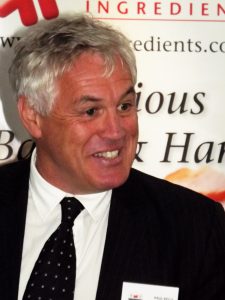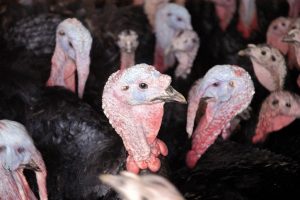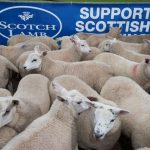Independent butchers in unique position for turkey market
The turkey market in the UK is consolidating with fewer farmers rearing the birds and fewer processors putting them on the market.

Paul Kelly speaking at the NFMFT annual meeting.
Paul Kelly from Kelly’s Turkeys as guest speaker at the National Federation of Meat and Food Traders’ (NFMFT) annual meeting in London said that the number of farmers had fallen from 2,300 in 1980 to just 950 last year and the number of processors was down from 22 to just four.
The number of breeders and genetics suppliers has also fallen from more than 15 in the 1970s to just three today – including Kelly’s Turkeys.
The turkey market sees eight million birds sold at Christmas time with eight million sold throughout the rest of the year.
However, Kelly told federation members that one of the major changes in the birds that are being sold is the length of time that most of the industrial scale production birds are allowed to grow.
Through genetics and feed regimes the commercially produced birds that use to take 21 weeks to grow in the 1970s now take just 10 weeks to reach the saleable weight of 6kg.
However, the smaller strains of birds that are grown traditionally sued to take 22 weeks to grow and still take 22 weeks to reach maturity.
“There is a large difference in shape between the big breeds and the smaller strains,” Kelly said. “The small strain can have up to 50% more breast meat.”
Kelly said that the difference between the two strains of birds was that the small strain is grown until it reaches maturity while the commercial strains are grown until they reach a set weight.
However, he said that the skeletal development of the birds takes up to 15 weeks and then they start to put on muscle between 15 and 21 weeks of development. After that the birds start to lay down fat.
The commercial birds do not start to put on full muscle because they have not reached skeletal maturity by the time they are slaughtered.
He said the small strains are bred for breed, maturity and are free range and are dry plucked and hung.

The number of turkey farmers has fallen.
The standard process sees birds that are fast growing and killed when they are the right weight not the right age. They are also wet processed, hot eviscerated and then deep chilled.
“Because of the wet processing, the bids cannot be hung,” Kelly added.
The UK market for turkeys sees them sold through 8,523 supermarkets but also through an equal number of smaller outlets including 5,756 butchers’ shops, 1,465 farm shops and 1,000 farm gate sales and also through 2,400 delis.
The smaller strain dry plucked birds are more expensive selling at around £13.50 per kilo compared to £4.60 for a standard fresh bird, but the smaller birds have the niche market attraction for consumers.
Kelly said the main challenge to the turkey market in the UK is from imported butterflies that sol sold as marginally costed products.
The supermarkets are not able to source their birds from the small producers because most do not have a full EEC licence and most locally sourced turkeys are slaughtered on the farm.
However, the independent butchers are in a unique position to deal with the farms. “The top end sector of the market knows where their food comes from and they want to know,” Kelly commented.
“They are attracted to the artisan, boutique end of the market which can promote itself with a different image. Local food with provenance is what the affluent consumer wants.”

 Supply and demand key to sheep trade
Supply and demand key to sheep trade
